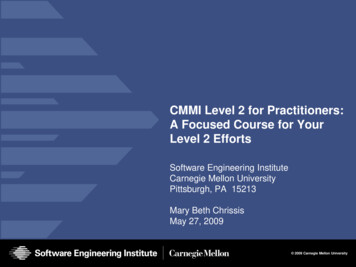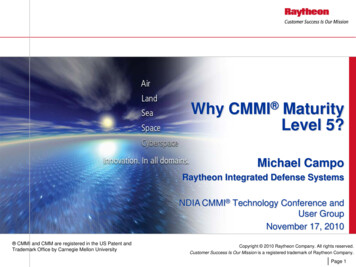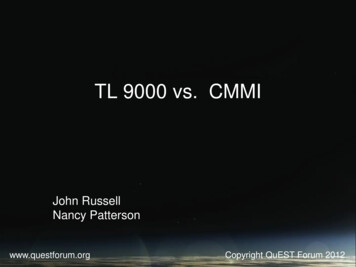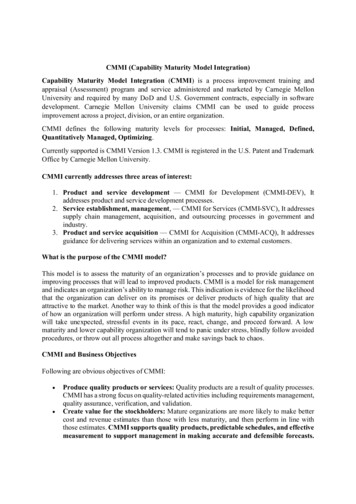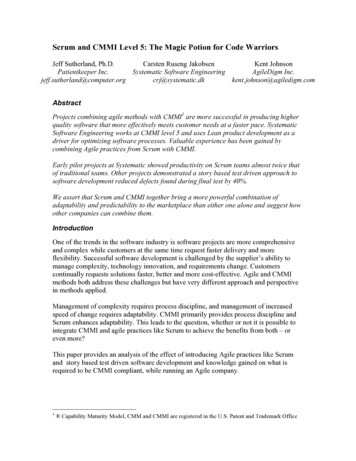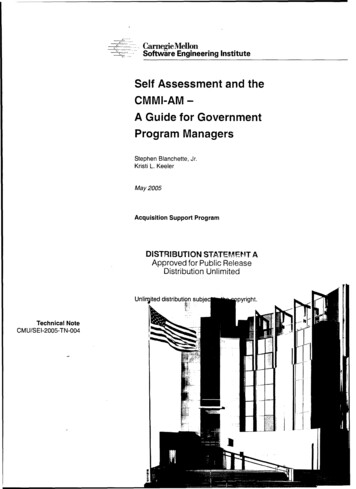
Transcription
CamegieMellon--Software Engineering InstituteSelf Assessment and theCMMI-AM A Guide for GovernmentProgram ManagersStephen Blanchette, Jr.Kristi L. KeelerMay 2005Acquisition Support ProgramDISTRIBUTION STATEPMIET AApproved for Public ReleaseDistribution UnlimitedUnlir"ited distribution subjecpyright.Technical NoteCMU/SEI-2005-TN-004SIMS.
Self Assessment and theCMMI-AM A Guide for GovernmentProgram ManagersStephen Blanchette, Jr.Kristi L. KeelerMay 2005Acquisition Support ProgramUnlimited distribution subject to the copyright.Technical NoteCMU/SEI-2005-TN-00420051223029
This work is sponsored by the U.S. Department of Defense.The Software Engineering Institute is a federally funded research and development center sponsored by the U.S.Department of Defense.Copyright 2005 Carnegie Mellon University.NO WARRANTYTHIS CARNEGIE MELLON UNIVERSITY AND SOFTWARE ENGINEERING INSTITUTE MATERIAL ISFURNISHED ON AN "AS-IS" BASIS. CARNEGIE MELLON UNIVERSITY MAKES NO WARRANTIES OF ANYKIND, EITHER EXPRESSED OR IMPLIED, AS TO ANY MATTER INCLUDING. BUT NOT LIMITED TO,WARRANTY OF FITNESS FOR PURPOSE OR MERCHANTABILITY. EXCLUSIVITY. OR RESULTS OBTAINEDFROM USE OF THE MATERIAL. CARNEGIE MELLON UNIVERSITY DOES NOT MAKE ANY WARRANTY OFANY KIND WITH RESPECT TO FREEDOM FROM PATENT, TRADEMARK, OR COPYRIGHT INFRINGEMENT.Use of any trademarks in this report is not intended in any way to infringe on the rights of the trademark holder.Internal use. Permission to reproduce this document and to prepare derivative works from this document for internal use isgranted, provided the copyright and "No Warranty" statements are included with all reproductions and derivative works.External use. Requests for permission to reproduce this document or prepare derivative works of this document for externaland commercial use should be addressed to the SEI Licensing Agent.This work was created in the performance of Federal Government Contract Number F19628-00-C-0003 with CarnegieMellon University for the operation of the Software Engineering Institute, a federally funded research and developmentcenter. The Government of the United States has a royalty-free government-purpose license to use, duplicate, or disclose thework, in whole or in part and in any manner, and to have or permit others to do so, for government purposes pursuant to thecopyright license under the clause at 252.227-7013.For information about purchasing paper copies of SEI reports, please visit the publications portion of our Web mnl).
ContentsAbstract .123The CM MI Acquisition Module .1.1 A Brief History .vii111.2 The Acquisition Module .1.3 Im provem ent Via the Acquisition Module .23Self-Assessment Based on the CMMI-AM .2.1 Description .552.2Benefits .82.3Pitfalls .9Sum m ary .11Feedback .13Appendix AAcronyms and Abbreviations .15Appendix BCMMI-AM Evaluation Statements .17References .CMU/SEI-2005-TN-00425
iiCMU/SEI-2005-TN-004
List of FiguresFigure 1: The Acquirer/Supplier Mismatch .2Figure 2: Example CMMI-AM Self-Assessment Questions .6Figure 3: Example CMMI-AM Self-Assessment Scoring Sheet .7CMU/SEI-2005-TN-004iii
ivCMU/SEI-2005-TN-004
List of TablesTable 1: Characteristics of Different Appraisal Methods . 9CMU/SEI-2005-TN-004v
viCMU/SEI-2005-TN-004
AbstractUse of capability maturity models has become commonplace among software developmentorganizations, especially defense contractors. Government program offices. however, havelagged behind contractors in implementing their own process improvement programs. Thedifference in relative maturity between program offices and contractors sometimes makes itdifficult for program offices to adequately gauge the state of their programs. In 2004, theOffice of the Secretary of Defense announced the creation of the CMMI Acquisition Module(CMMI-AM). The module aids program offices in developing a level of parity with theirsuppliers in terms of process maturity.The first step in any process improvement endeavor is to determine the baseline state. Aprogram office can undergo an external appraisal, but generally that is not a cost-effectivesolution for an organization that is still a novice in process improvement. For organizationswith little process improvement experience, a better choice is to begin with a self-assessment.This guide provides program managers with general information about the CMMI-AM,details about the self-assessment technique, and the questions used in a self-assessment.After reading this guide, program managers can evaluate whether a self-assessment fits theirneeds, and if so, conduct one.CMMI is registered in the U.S. Patent and Trademark Office by Carnegie Mellon University.CMU/SEI-2005-TN-004vii
viiiCMU/SEI-2005-TN-004
1 The CMMI Acquisition Module1.1A Brief HistoryUse of capability maturity models has become commonplace in the software industry,especially among defense contractors. Beginning with the Capability Maturity Model forSoftware (SW-CMM), and now continuing with the Capability Maturity Model Integration(CMMI ) framework, software development organizations have achieved significant gains intheir ability to develop and deliver systems with predictable results [Goldenson 03]. Even afew government program offices have implemented process improvement programs withgood results [Capell 04, Kotchman 02].I However, most have lagged behind their contractorsSin the area of process maturity. The difference in relative maturity frequently makes itdifficult for program offices to accurately gauge the state of their programs and communicatewith their contractors, ultimately leading to unpredictable results for those programs[Gallagher 04]. Figure 1 depicts the acquirer/supplier mismatch. Situations where bothacquirers and suppliers possess high degrees of technical and management skill tend to yieldthe best results, whereas other combinations tend to increase the risk of failure.The government increasingly relies on prime contractors, lead integrators, and the like, tooperate with limited supervision. Such trust in these parties is not always warranted. It isincumbent upon the government to maintain some level of "smart buyer" capability in orderto provide effective program management, oversight, and stewardship of taxpayer funds. Capability Maturity Model and CMMI are registered in the U.S. Patent and Trademark Office byCarnegie Mellon University.Additional information about specific, quantitative results of process improvement based on CMMImodels may be found at 005-TN-0041
MismatchMatchedmature acquirer mentorslow maturity supplierare both highmaturityacq uirer and supplier1outcome not ustomer encouragesshortcuts.0-JLowsuccessMismatchno disciplineno processno productTechnical&Management Skillhighest probability of''SupplierHighFigure 1: The Acquirer/SupplierMismatchIn 2002, Congressional leaders recognized the need for the defense department to improve itsability to manage programs, especially those with significant software content. Theyincluded Section 804 in the National Defense Authorization Act for Fiscal Year 2003, whichrequires each of the Services and Defense Agencies to establish software acquisitionimprovement programs [PL 02]. Specifically, Section 804 states:"The Secretary of each military department shall establish a program toimprove the software acquisition processes of that military department.The head of each Defense Agency that manages a major defense acquisitionprogram with a substantial software component shall establish a program toimprove the software acquisition processes of that Defense Agency."Clearly, there is both a need and an imperative to improve the government's ability tosuccessfully acquire systems that have high software content.1.2The Acquisition ModuleTo help Department of Defense program offices improve their abilities, the Office of theSecretary of Defense (OSD) announced the creation of the CMMI Acquisition Module(CMMI-AM) in 2004 [Bernard 04]. The module, which draws practices from the CMMI2CMU/SEI-2005-TN-004
framework in addition to other relevant models, 2 was developed to aid program offices indeveloping a level of parity with their suppliers in terms of process maturity.It is important to distinguish between CMMI models and modules. In general. CMMI modelsare the official documents defining best practices for a given discipline. Organizations canuse models to achieve a maturity level rating. CMMI modules are excerpts from the model,often with additional material provided on a trial basis. Organizations can use modules toidentify their strengths and weaknesses, but cannot base a maturity level rating on them[Gallagher 04]. The CMMI-AM is a module.For the CMMI-AM, selected practices were extracted from CMMI-SE/SW/IPPD/SS Version1.1 [SEI 02] and other source models to support acquisition organizations as they planprojects, prepare and execute solicitations, monitor and control suppliers, and manageprograms. In general, the CMMI-AM uses the terminology of the source models, withacquisition-oriented amplification text added to help acquirers interpret the meaning of theprocess areas in the acquisition context. These practices provide a basis for discipline andrigor, allowing the acquisition process to be executed with repeated success [Bernard 04].1.3Improvement Via the Acquisition ModuleIntroduction of the CMMI-AM raises a very important question: How can a program officebest make use of it?Process improvement using the CMMI framework as a guide entails a significantcommitment of resources and time. For program offices where process improvement maynot have been a priority in the past, undertaking a serious process improvement effort can bedaunting. The structure of the CMMI has been developed to allow an organization to selectareas for improvement based upon business needs. Rather than investing in processimprovement aimed at a specific group of processes, subsections of the model can be selectedto support improvement in those areas of the business that require immediate attention. Thenext step is to determine what those 'immediate attention' areas might be for an organization.For acquisition program offices, this is where the CMMI-AM is most useful. The CMMIAM, in effect, establishes a "starter set" of process areas that are relevant to acquisition.Defining a set of high-priority process areas is only the beginning, however. The next step isto determine where an organization stands with respect to those process areas. To accomplishthis task, there are two main choices. One is to use the Standard CMMI Appraisal Methodfor Process Improvement (SCAMPISM), which provides a standardized approach forThe other relevant models include the Software Acquisition Capability Maturity Model (SA-CMM)framework [Cooper 02] and the Federal Aviation Administration (FAA) Integrated CapabilityMaturity Model (FAA-iCMM) [FAA 01].sM SCAMPI is a service mark of Carnegie Mellon University.2CMU/SEI-2005-TN-0043
determining process performance: The other is to perform a self-assessment. For a programoffice with limited process improvement experience and resources. this may be a moresuitable first step.Certainly, acquisition organizations can elect to pursue a SCAMPI Class A appraisal to gain afirst insight into their process maturity, but that is generally not a cost-effective solution forany organization that is initiating a formal process improvement effort. Self-assessment maybe a better choice for these organizations because using a SCAMPI technique requires someunderstanding of process improvement and the CMMI framework. Additionally, theSCAMPI appraisal method requires the participation of staff that have been formallyeducated and authorized to support the execution of the method. In environments where therequisite level of understanding and training have not yet been reached, even the less rigorousSCAMPI B and C methods may be inappropriate as a first step (although SCAMPI B or Cwould be appropriate next steps after an organization has achieved some level ofimprovement following a self-assessment).3There are three classes of SCAMPI: "A," "B," and "C," with A being the most rigorous, and theonly one that can result in a rating relative to CMMI maturity level.4CMU/SEI-2005-TN-004
2 Self-Assessment Based on the CMMI-AM2.1DescriptionIn an organization where process maturity is a new concept, a self-assessment offers an easyentr6e to the world of process improvement. As the term implies, self-assessment is a meansby which an organization assesses compliance to a selected reference model or modulewithout requiring a formal method. Self-assessment helps organizations find gaps betweentheir current practices and the practices identified in the CMMI-AM. This early gapidentification allows program offices to begin improving their business practices beforeexposing themselves to the external scrutiny of a SCAMPI evaluation. The results of theself-assessment also can be used to educate the organization about the acquisition module aswell as about the requirements of the formal appraisal method.The mechanics of a self-assessment are simple. Using a survey, acquisition office personnelrespond to a series of questions based on their understanding of how work is performed intheir organization. To encourage candor in the responses, program offices should administerthe survey confidentially. The individual responses are then aggregated, averaged, andpresented to the program office staff for discussion and further action.Figure 2 helps illustrate these points. It shows examples of the types of statements to whichan organization responds in a CMMI-AM self-assessment. A full assessment would havemany more questions covering all the process areas described in the CMMI-AM, as outlinedin Appendix B.The statements are deliberately devoid of process model terminology; instead, they uselanguage that should be more familiar and accessible to program office personnel.Respondents score each statement from 1 to 10, where 1 represents the statement on the leftand 10 represents the statement on the right.Within a program office, key personnel respond to the statements based on their own point ofview. Key personnel includes, for example, the program manager and deputy programmanager, the chief engineer, the chief software engineer, the contracts specialist, the businessmanager, and the leads of integrated product teams (IPTs). The goal is to get the widestresponse possible to avoid skewing results.CMU/SEI-2005-TN-0045
1. Estimates are based on wild guessesor dictated from above,12.2647234375623891078910Actual performance and progress ofthe project are monitored against theproject plan.4564789101Corrective actions are managed toclosure when the project'sperformance or results deviatesignificantly from the plan.It is difficult to know when theproject has deviated from the planbased on the data we review,110 1Commitments to the project plan areestablished and maintained.We track progress based onpersonality and an arbitrarybaseline,298A project plan is established andmaintained as the basis formanaging the project.65We rarely seek commitments fromthose affected by the project plan.15.3214.54Plans are rarely written down nor dothey reflect current project activities,13.3Estimates of project planningparameters (i.e, scope, taskattributes, lifecycle, cost, effort, etc.)are established and maintained.5678910Figure 2: Example CMMI-AM Self-Assessment Questions4Figure 3 depicts a graphical example of how self-assessment results might be aggregated forfurther study and discussion within an organization. In this example, a fictitious organizationassessed itself against the project management process areas described in the CMMI-AM.The horizontal axis shows the individual process areas, while the vertical axis shows the4Excerpted from the SEI white paper "CMMI-AM:- Goal Implementation Survey" by Brian P.Gallagher. The full list of questions appears in Appendix B of this document.6CMU/SEI-2005-TN-004
scores. The bars depict the range of scores for each process area. Mean scores are denotedby the boxes.10-Leverage Points9-30 6E012F4- --sP0 dP-Barriers-I-- -e,4CS oCM/FFigure 3: Example CMMI0-AM Self-Assessment Scoring Sheet5In this example, the fictitious organization rated itself on the low side of average overall, asdetermined by the mean scores (all less than 5). The organization rated two process areas,Establish Estimates and Select Suppliers, low (mean scores just below 3.5). One processarea, Manage Corrective Action to Closure, received scores as low as 1 and as high as 10,with a mean score of just under 5. All of the process areas indicate a wide range ofresponses.The fictitious acquisition office can now use the scoring sheet to open a dialogue aboutprocess implementation in the organization. They can investigate the disparity of responsesamong the staff and discuss what needs to be done to get a consistent set of responses (i.e.,why is it that someone in this program office thinks that corrective actions are not managedto closure and another person believes that the program office uses a rigorous method tomanage corrective actions to closure?). After the disparity in responses is addressed, theprogram office can use the data from the self-assessment to discuss what needs to be done toraise the average response (i.e., what does the program office need to do to establish andmaintain a more rigorous method to track corrective actions to closure?). When the averageresponse for each process area is near 10 and the range of responses is smaller, the program5 Excerpted from the companion tool to the white paper "CMMI-AM: Goal Implementation Survey"by Brian P. Gallagher.CMU/SEI-2005-TN-0047
office may be ready for a SCAMPI appraisal. Self-assessments tend to be optimistic, sofollowing up with a SCAMPI appraisal after some initial improvements have been made is agood way to hone processes based on objective insights.2.2BenefitsSelf-assessments do not impact the daily routine of a program office significantly; they donot require the organization to accommodate a site visit by an external assessment team.Typically, a SCAMPI A appraisal requires on-site interviews to confirm implementation anduse of documented processes. This type of activity may require multiple visits over a periodof weeks, depending upon the size and complexity of the program office. Self-assessmentsstill require that program office staff take time to answer the questions, but this is generallysubstantially less effort than that required for any independent appraisal like a SCAMPI.Self-assessments do not require documentation as evidence of compliance with a referencemodel, although having documentation can be invaluable for analysis of results, helping toanswer questions like "How do we know?" The SCAMPI methods all require direct artifactsof implementation for each practice within the reference model or module. Self-assessmentsin fact, do not require any evidence at all. Generally, because of the lack of formality of theself-assessment, they tend to be less expensive to the program office.The general characteristics of self-assessment in contrast to the three classes of SCAMPIappraisal are shown in Table 1. These characteristics are shown to provide a very high-levelview of the impact of appraisals. One can easily see why self-assessment is an attractivealternative for beginning a process improvement effort. The increasing rigor of the SCAMPImethods offer better, and more objective, visibility into a program office's operation,providing the opportunity to fine-tune processes. The combination of techniques provides ameans for program offices to bootstrap their improvement efforts progressively.8CMU/SEI-2005-TN-004
Table 1: Characteristicsof Different Appraisal Methods6MethodsSCAMPISelfAssessmentClass CCharacteristicsAmount of ObjectiveEvidenceClass BClass ANoneLowMediumHighNoNoNoYes*(*but not(RequiredDocumentation)Ratings Generatedfor theCMMIAM alone)Resource NeedsLowLowMediumHighTeam SizeNoneSmallMediumHigh2.3 PitfallsAlthough self-assessments can be a low-impact, low-cost way of gaining insight into anorganization's process maturity, they are not without shortcomings.For one thing, there is the tendency of people in an organization to rate themselves higherthan an external, objective appraisal team. Such over-rating can happen for a variety ofreasons. In an organization that is somewhat unfamiliar with process improvement ormaturity models, there is plenty of room for interpretation of the questions. It is notsurprising that people make their best guess.when faced with questions about an unfamiliarsubject. Sometimes people miss the point entirely, and instead of trying to provide an honestevaluation, they try to guess the "right" answer. Sometimes people provide the answer thatthey think the boss wants to hear. These are all very common (and human) responses whenan organization embarks on a path to affecting change.6This table has been adapted from the one-found in AppraisalRequirementsfor CMMI, Version 1.1(ARC, V1.1) [SE1 01].CMU/SEI-2005-TN-0049
The self-assessment process does not require documentation to "prove" that businesspractices have been implemented for the organization. In addition. no evidence that showsthe execution of the documented practices is required to answer the questions on the selfassessment. If the organization lacks process documents, a self-assessment may not uncoverthe shortfall. This lack of documentation makes it difficult to later demonstrate repeatabilityof the business practices in a formal manner. More importantly, documented processesprovide the basis for uniform understanding and execution of an organization's business.External auditing organizations, such as the Government Accountability Office (GAO),generally do not regard self-assessment results as meaningful because of the informality andsubjective nature of self-assessments. To achieve credibility, techniques such as the SCAMPIare still needed.Finally, in some cases, it might be difficult to really know what the results mean. Dogenerally negative results indicate widespread process problems, a failure to communicateeffectively within the organization about processes, or a simple misunderstanding of the selfassessment questionnaire? Likewise, do favorable results mean the organization is doingwell, or do they indicate people are guessing at what they believe the desired answer to be? Aself-assessment cannot answer these questions. Only a trained appraisal team can helpanswer such questions. This limitation does not invalidate self-assessment results; rather itsupports the CMMI product suite approach of building upon the results of various gapanalysis and triage techniques. The self-assessment tool can be used as an initial triagetechnique, but it must be considered with appropriate cynicism. More formal training, andthe employment of appraisal techniques like the SCAMPI B or C, should follow the selfassessments.10CMU/SEI-2005-TN-004
3 SummaryThis document provided background and high-level information about two starting points forprocess improvement in acquisition program offices. The CMMI-AM provides the "starterset" of best practices that acquisition offices can use to guide their improvement efforts. Selfassessments provide a relatively easy way to begin the training and awareness work that iscritical to the success of an improvement effort, especially for program offices that are justgetting started in process improvement.It has been said that a 'journey of a thousand miles begins with the first step.' Selfassessments based on the CMMI-AM support process improvement initiatives in acquisitionprogram offices and are a first step in the right direction.CMU/SEI-2005-TN-00411
12CMU/SEI-2005-TN-004
FeedbackThrough its Acquisition Support Program (ASP), the Carnegie Mellon SoftwareEngineering Institute (SEI) is working to help improve the acquisition of software-intensivesystems across the U.S. government. As part of its mission, the SEI is pleased to discuss theinformation in this report in more detail. The authors also welcome comments:Stephen Blanchette, Jr. (sblanche @sei.cmu.edu)Kristi L. Keeler (kkeeler@sei.cmu.edu)The SEI has tools available to help program offices employ CMMI-AM based selfassessments. For more information about tools for self-assessment, contact StephenBlanchette, Jr. at the email address above.For more information about the CMMI-AM in general, contact ASP Director, BrianGallagher (bg@sei.cmu.edu). Carnegie Mellon is registered in the U.S. Patent and Trademark Office by Carnegie MellonUniversity.CMU/SEI-2005-TN-00413
14CMU/SEI-2005-TN-004
Appendix AAcronyms and AbbreviationsThe alphabetical list below contains all acronyms, abbreviations, and their meanings as usedin this report.ARCAssessment Requirements for CMMIASPAcquisition Support ProgramCMMICapability Maturity Model IntegrationCMMI-AMCMMI Acquisition ModuleCMMISE/SW/IPPD/SSCMMI for System Engineering/Software Engineering/IntegratedProduct and Process Development/Supplier SourcingCMUCarnegie Mellon UniversityDoDDepartment of DefenseESCElectronic Systems CenterFAAFederal Aviation AdministrationGAOGovernment Accountability OfficeiCMMIntegrated Capability Maturity ModelIPPDIntegrated Product and Process DevelopmentIPTIntegrated Product TeamOSDOffice of the Secretary of DefenseSA-CMMSoftware Acquisition Capability Maturity ModelSCAMPIStandard CMMI Appraisal Method for Process ImprovementSEISoftware Engineering InstituteSRSpecial ReportSW-CMMCapability Maturity Model for SoftwareCMU/SEI-2005-TN-00415
TNTechnical NoteTRTechnical Report16CMU/SEI-2005-TN-004
CMMI-AM Evaluation StatementsAppendix BThe following list is the full list of goal implementation survey questions7 for CMMI-AM,version 1.0.Estimates are based on wild guesses orEstimates of project planningdictated from above.parameters (i.e. scope, task attributes.lifecycle. cost, effort. etc.) areestablished and maintained.S22.34567890Plans are rarely written down nor doA project plan is established andthey reflect current project activities.maintained as the basis for managingthe project.13.23456We rarely seek commitments from74.2391Commitments to the project plan arethose affected by the project plan.18established and maintained.456We track progress based on personality7891Actual performance and progress of theand an arbitrary baseline.project are monitored against theproject plan.2734567891Excerpted from the SEI white paper "CMMI-AM: Goal Implementation Survey" by Brian P.Gallagher.CMU/SEI-2005-TN-00417
5.It is difficult to know when the projectCorrective actions are managed tohas deviated from the plan based on theclosure when the project's performancedata we review.or results deviate significantly from theplan.I26.4356789The project is conducted using aThere are no organizational assetsdefined process that is tailored from theavailable to assist in conducting theorganization's set of standardproject.processes.S27.3546789Relevant stakeholders for our projectCoordination and collaboration of theare avoided or unknown.project with relevant stakeholders areconducted.28.34567890The project is conducted using theProject team members do not share aproject's shared vision.common vision of success.29.34567891The integrated teams needed to executeOur integrated teams are ad hoc and ill-the project are identified, defined,defined.structured, and tasked.218345678910CMU/SEI-2005-TN-004
10.Our program lacks a coherent riskPreparation for risk management ismanagement strategy, roles are ill-conducted.defined, and my responsibility forparticipating in the process is not clear.211.45678910We deal with problems and issues,Risks are identified and analyzed tothere's no time to think proactively.determine their relative importance.S212.33456Risk mitigation is ad hoc, and only7891Risks are handled and mitigated, wheredealt with in crisis mode.appropriate, to reduce adverse impactson achieving objectives.S213.3456Teams are composed of whoever is7891A team composition that provides theavailable or understaffed due to lack ofknowledge and skills required toresources.deliver the team's product is.established and maintained.114.23456789Our integrated teams operate ad hocOperation of the integrated team iswithout operating procedures orgoverned according to establishedcharters.principles.115.1023456Our project scrambles to prepare for7891The project is prepared to conduct thesolicitation activities and has to "makesolicitation.it up" on the fly.12C
details about the self-assessment technique, and the questions used in a self-assessment. After reading this guide, program managers can evaluate whether a self-assessment fits their needs, and if so, conduct one. CMMI is registered in the U.S. Patent and Trademark Office by Carnegie Mellon University. CMU/SEI-2005-TN-004 vii


